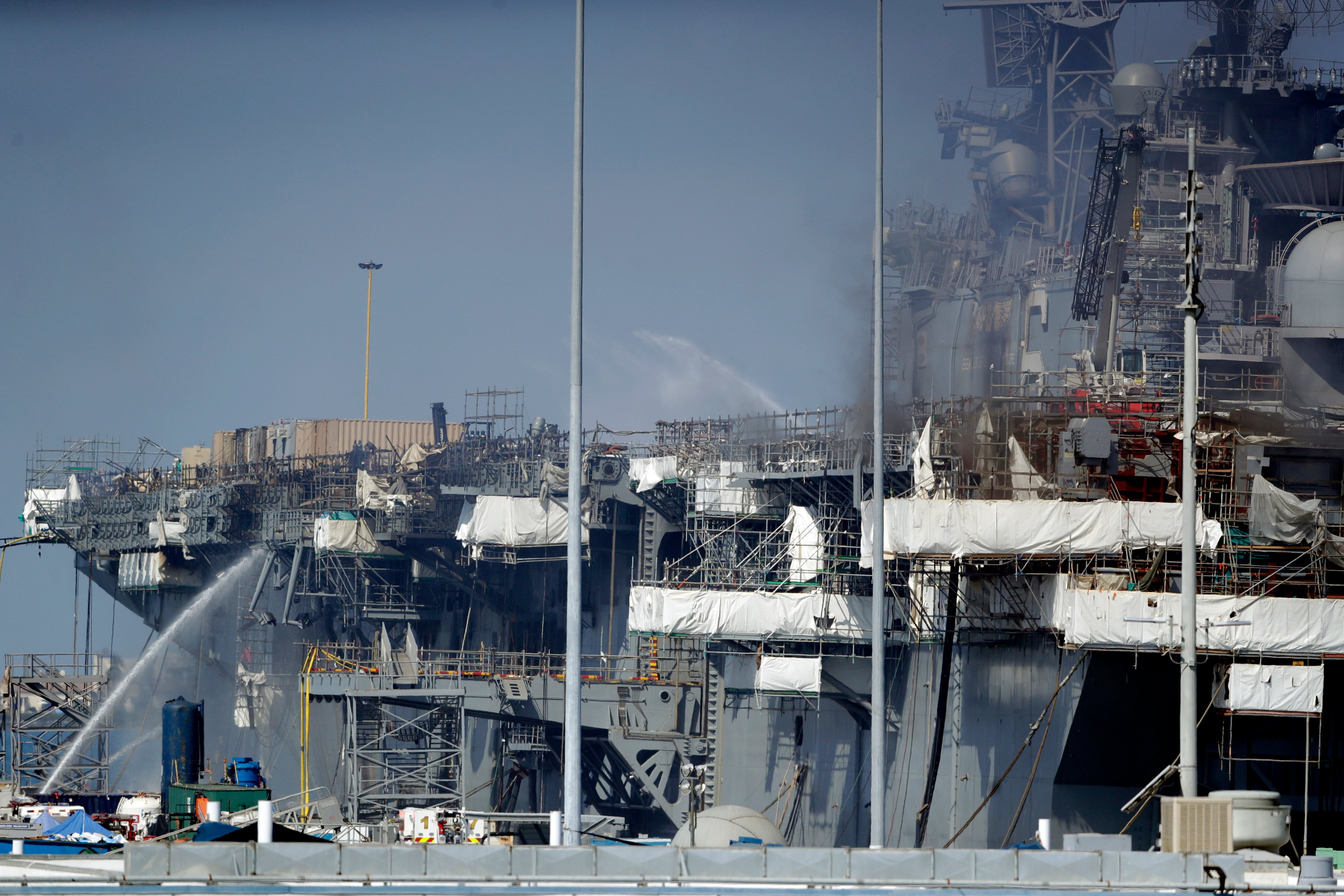Navy disciplines officers in massive ship fire
Navy leaders have disciplined more than 20 senior officers and sailors in connection with widespread leadership and other failures that contributed to the July 2020 arson fire that destroyed the USS Bonhomme Richard

Your support helps us to tell the story
From reproductive rights to climate change to Big Tech, The Independent is on the ground when the story is developing. Whether it's investigating the financials of Elon Musk's pro-Trump PAC or producing our latest documentary, 'The A Word', which shines a light on the American women fighting for reproductive rights, we know how important it is to parse out the facts from the messaging.
At such a critical moment in US history, we need reporters on the ground. Your donation allows us to keep sending journalists to speak to both sides of the story.
The Independent is trusted by Americans across the entire political spectrum. And unlike many other quality news outlets, we choose not to lock Americans out of our reporting and analysis with paywalls. We believe quality journalism should be available to everyone, paid for by those who can afford it.
Your support makes all the difference.Navy leaders have disciplined more than 20 senior officers and sailors in connection with widespread leadership and other failures that contributed to the July 2020 arson fire that destroyed the USS Bonhomme Richard.
The most significant actions were taken against members of the ship's leadership team, including letters of reprimand and pay cuts for the former commander and executive officer. And Navy Secretary Carlos Del Toro issued a letter of censure to retired Vice Adm. Richard Brown, who was the commander of U.S. Pacific Fleet at the time of the fire.
The ship was undergoing a two-year, $250 million upgrade pierside in San Diego when the fire broke out. About 115 sailors were on board, and nearly 60 were treated for heat exhaustion, smoke inhalation and minor injuries. The failure to extinguish or contain the fire led to temperatures exceeding 1,200 degrees Fahrenheit in some areas, melting sections of the ship into molten metal that flowed into other parts of the ship.
A Navy report last year concluded that the massive five-day blaze was preventable and unacceptable, and that there were lapses in training, coordination, communications, fire preparedness, equipmentment maintenance and overall command and control. And, while one sailor — Seaman Apprentice Ryan Mays — has been charged with setting the fire, the report found that failings by about three dozen officers and sailors either directly led to the ship’s loss or contributed to it.
“When leaders’ actions or inactions result in the loss of life or capital resources, the senior leadership of the Department of the Navy has a responsibility to determine the root cause and hold those accountable,” Del Toro said in a message sent to the Department of the Navy on June 2. “This fire could have been prevented with adequate oversight into the ship’s material condition and the crew’s readiness to combat a fire.”
The Navy on Friday laid out the disciplinary actions taken by Adm. Samuel Paparo, current commander of Pacific Fleet. In most cases, Paparo issued letters in the sailors' personnel files that ranged in severity. In many cases a disciplinary letter can be career-ending.
According to the Navy, Paparo gave punitive letters of reprimand and pay forfeitures to Capt. Gregory Scott Thoroman, the ship's former commanding officer, and to Capt. Michael Ray, the former executive officer. Former Command Master Chief Jose Hernandez was given a punitive letter of reprimand.
Others who received letters in their files were Rear Adm. Scott Brown, who was director of fleet maintenance, and Rear Adm. Eric Ver Hage, commander of the Navy Regional Maintenance Center.
Mays is facing a court martial, and was charged with aggravated arson and the willful hazarding of a vessel. He has denied setting the fire. Mays set the fire because he was disgruntled after dropping out of Navy SEAL training, prosecutors said. His defense lawyers said there was no physical evidence connecting him to the blaze.
The Navy report on the fire issued last year spread blame across a wide range of ranks and responsibilities, from Brown to senior commanders, lower ranking sailors and civilian program managers. It cited 17 for failures that “directly” led to the loss of the ship, while 17 others “contributed” to the loss of the ship. Two other sailors were faulted for not effectively helping the fire response. Of the 36, nine were civilians.
The report directly faulted the ship’s three top officers — Thoroman, Ray and Hernandez — for not effectively ensuring the readiness and condition of the ship. And it said that the failures of Vice Adm. Brown; Rear Adm. Scott Brown and Ver Hage all “contributed to the loss of the ship.”
The fire marked one of the worst noncombat warship disasters in recent memory and the vessel had to be scrapped. It would cost an estimated $4 billion to replace.
The report described a ship in disarray, with combustible materials scattered and stored improperly. It said maintenance reports were falsified, and that 87% of the fire stations on board had equipment problems or had not been inspected.
It also found that crew members didn’t ring the bells to alert sailors of a fire until 10 minutes after it was discovered. Those crucial minutes, the report said, caused delays in crews donning fire gear, assembling hose teams and responding to the fire.
Sailors also failed to push the button and activate the firefighting foam system, even though it was accessible and could have slowed the fire’s progress. “No member of the crew interviewed considered this action or had specific knowledge as to the location of the button or its function,” the report said.
More broadly, the crew was slammed for “a pattern of failed drills, minimal crew participation, an absence of basic knowledge on firefighting” and an inability to coordinate with civilian firefighters.